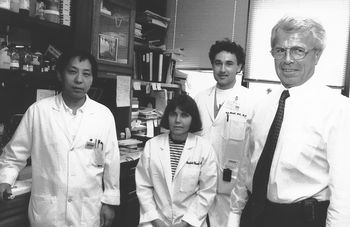Cancer-fighting drug may also help wounds heal

Dr. Carl Hellerqvist (right) with his research team (from left) Changlin Fu, Ph.D., Dr. Barbara Wamil and Dr. Artur Wamil. (Photo by Donna Jones Bailey)
A drug first developed at Vanderbilt University Medical Center to fight cancer may also help reconnect neurons following spinal cord injuries.
In addition to its promise for the treatment of spinal cord injuries, the bacterial toxin CM-101 could also prove useful in helping wounds heal faster and treating rheumatoid arthritis, its discoverer says.
CM-101 was first studied as an anti-cancer drug used to inhibit the flow of blood to tumors by destroying newly formed blood vessels. Clinical trials for this use are ongoing.
"By stopping the flow of blood to tumors, CM-101 effectively stops tumor growth," said Dr. Carl G. Hellerqvist, associate professor of Biochemistry and Medicine and discoverer of CM-101. "It is this same process that we hope will work in rheumatoid arthritis and spinal cord injuries."
CM-101 was originally discovered by Hellerqvist while studying the deadly lung disease group-B streptococcus in infants. Also involved in its discovery was Dr. Mildred T. Stahlman and Dr. Hakan W. Sundell, professors of Pediatrics, and Dr. Jorge Rojas, associate clinical professor of Pediatrics.
The streptococcus bacterium produces the toxin, CM-101, which then attacks newly formed blood vessels in the lungs.
"Soon after the discovery of the toxin it was clear to me that we should be looking at CM-101 as an anti-cancer drug, since it seemed logical to assume it would also attack the neighboring blood vessels of the tumors," said Hellerqvist.
Following the same line of reasoning, Dr. Barbara Wamil, researhc assistant professor of Biochemistry, and Hellerqvist have recently begun looking at CM-101 to stop rheumatoid arthritis from ruining joints and to facilitate wound healing.
"In rheumatoid arthritis, the synovial fibroblasts can be considered Œtransformed¹ and as such proliferate wildly, causing a pathoangioginic process that eventually destroys the joint," said Hellerqvist.
It is this out-of-control formation of new blood vessels, or pathoangiogenesis, that is affected by CM-101. These anti-pathoangiogenic properties of CM-101, which do not affect normal growth, inhibit the progression of the joint destroying inflammatory process.
"The preclinical results from animal models are very promising for this type of treatment," said Hellerqvist. "The same attributes of CM-101 are at work in helping to heal wounds and prevent spinal cord injuries."
In both of these injuries, the formation of new blood vessels is often a barrier to healing. Nerves and skin are unable to reconnect due to scar tissue that has formed.
"When we inhibit the formation of scar tissue we can facilitate the reconnection of nerves and speed up the healing process for skin," said Hellerqvist.
In order to build a better base of knowledge about the toxin, Changlin Fu, Ph.D., research assistant professor of Biochemistry, and Smriti Bardhan, Ph.D., research instructor in Biochemistry, are investigating the expression and cloning of receptors with which CM-101 interacts.
"The identification of the receptor with which CM-101 interacts will allow us to discover orally available, second generation drugs that can be used in the future as alternatives to CM-101 itself in some diseases," said Hellerqvist.
Such second-generation drugs would also be developed to alleviate the often-fatal consequences of group B streptococcus infection in newborns.













